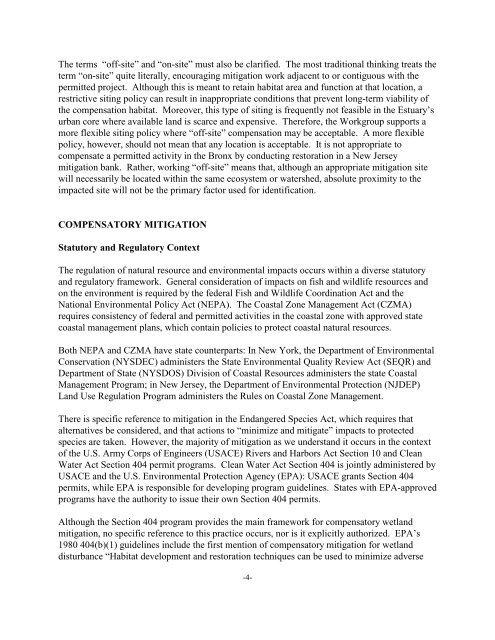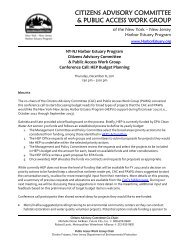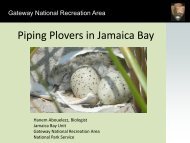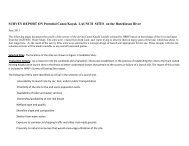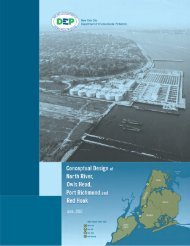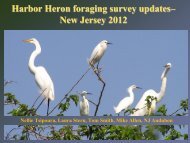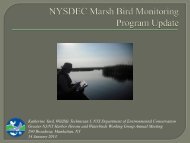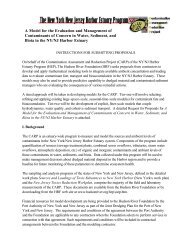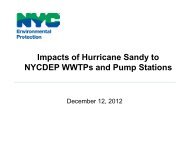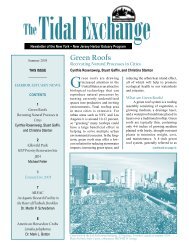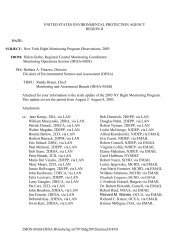DraftMitigation .pdf - New York-New Jersey Harbor Estuary Program
DraftMitigation .pdf - New York-New Jersey Harbor Estuary Program
DraftMitigation .pdf - New York-New Jersey Harbor Estuary Program
Create successful ePaper yourself
Turn your PDF publications into a flip-book with our unique Google optimized e-Paper software.
The terms “off-site” and “on-site” must also be clarified. The most traditional thinking treats the<br />
term “on-site” quite literally, encouraging mitigation work adjacent to or contiguous with the<br />
permitted project. Although this is meant to retain habitat area and function at that location, a<br />
restrictive siting policy can result in inappropriate conditions that prevent long-term viability of<br />
the compensation habitat. Moreover, this type of siting is frequently not feasible in the <strong>Estuary</strong>’s<br />
urban core where available land is scarce and expensive. Therefore, the Workgroup supports a<br />
more flexible siting policy where “off-site” compensation may be acceptable. A more flexible<br />
policy, however, should not mean that any location is acceptable. It is not appropriate to<br />
compensate a permitted activity in the Bronx by conducting restoration in a <strong>New</strong> <strong>Jersey</strong><br />
mitigation bank. Rather, working “off-site” means that, although an appropriate mitigation site<br />
will necessarily be located within the same ecosystem or watershed, absolute proximity to the<br />
impacted site will not be the primary factor used for identification.<br />
COMPENSATORY MITIGATION<br />
Statutory and Regulatory Context<br />
The regulation of natural resource and environmental impacts occurs within a diverse statutory<br />
and regulatory framework. General consideration of impacts on fish and wildlife resources and<br />
on the environment is required by the federal Fish and Wildlife Coordination Act and the<br />
National Environmental Policy Act (NEPA). The Coastal Zone Management Act (CZMA)<br />
requires consistency of federal and permitted activities in the coastal zone with approved state<br />
coastal management plans, which contain policies to protect coastal natural resources.<br />
Both NEPA and CZMA have state counterparts: In <strong>New</strong> <strong>York</strong>, the Department of Environmental<br />
Conservation (NYSDEC) administers the State Environmental Quality Review Act (SEQR) and<br />
Department of State (NYSDOS) Division of Coastal Resources administers the state Coastal<br />
Management <strong>Program</strong>; in <strong>New</strong> <strong>Jersey</strong>, the Department of Environmental Protection (NJDEP)<br />
Land Use Regulation <strong>Program</strong> administers the Rules on Coastal Zone Management.<br />
There is specific reference to mitigation in the Endangered Species Act, which requires that<br />
alternatives be considered, and that actions to “minimize and mitigate” impacts to protected<br />
species are taken. However, the majority of mitigation as we understand it occurs in the context<br />
of the U.S. Army Corps of Engineers (USACE) Rivers and <strong>Harbor</strong>s Act Section 10 and Clean<br />
Water Act Section 404 permit programs. Clean Water Act Section 404 is jointly administered by<br />
USACE and the U.S. Environmental Protection Agency (EPA): USACE grants Section 404<br />
permits, while EPA is responsible for developing program guidelines. States with EPA-approved<br />
programs have the authority to issue their own Section 404 permits.<br />
Although the Section 404 program provides the main framework for compensatory wetland<br />
mitigation, no specific reference to this practice occurs, nor is it explicitly authorized. EPA’s<br />
1980 404(b)(1) guidelines include the first mention of compensatory mitigation for wetland<br />
disturbance “Habitat development and restoration techniques can be used to minimize adverse<br />
-4-


